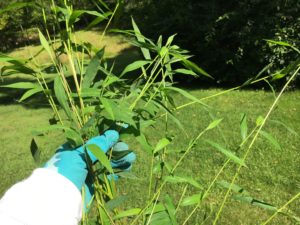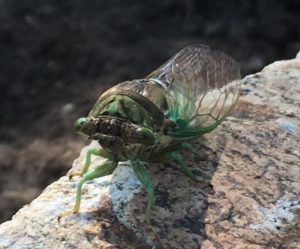Hello, fellow lovers of all things green. In recent weeks, while recording the podcast, I’ve apologetically mentioned the ruckus of cicadas in the trees. The sounds remind me of a cicada encounter during a garden installation and a reminiscence of how the late summer sounds of cicadas singing give the nagging indication it’s time for back to school.
Cicadas Sing Back to School
The trepidation of the first day of school was more about the nervousness of being in a new class. Once the newness wore off, it wasn’t that bad. As grownups, there’s still much to learn in this garden of life beyond the classroom for those who remain curious.
While overseeing a project designed for Morristown Airport in New Jersey, a cicada sat down beside me on a boulder we placed in a garden. The Little Miss Muffet poem came to mind, though he didn’t frighten me away. Instead, I sat in awe of his big green eyes and translucent wings and asked out loud, “Are you okay?” Then came curious looks from the landscapers. I wondered if the digging brought the poor little guy to the surface before he was ready to emerge.
Annual vs. Periodical Cicadas
You may recall the cicada invasion a few years ago. But what sat beside me was not a Periodical Cicada that emerges every 13 or 17 years. He was an Annual Cicada, also known as Dog-day or North American Cicada, that surfaces in late summer every year.
Their lifecycle is similar but shorter, only remaining underground for two to five years. Then they surface and molt to become adults with wings. They find their way onto deciduous trees and shrubs to mate. The loud, shrill are the males singing to attract the females. Leave it to the boys to make such a ruckus! But the girls cause damage when cutting slits into branches to lay eggs. The damage is not problematic, though, because there are relatively few Annual Cicadas, unlike when the swarms of Periodical Cicadas emerge. They don’t sting or bite and provide protein for wildlife such as birds and foxes.

A perfect time to weed out the undesirables, such as Japanese Stilt Grass
Back-to-School – Back to the Garden
The back-to-school cicada sound draws us back into the garden. It’s a perfect time to weed out the undesirables, such as Japanese Stilt Grass, before the seeds that remain viable for several years land in the soil. Microstegium vimineum is also known as Mary’s Grass, though I take no ownership. It looks like mini bamboo that seems to be taking over the world in shady forest floors and sunny garden spots.
It’s also an ideal time to tweak your garden with end-of-season perennial finds from your local nursery. For lawn enthusiasts, late August into September is a good time to fill in bald patches, aerate, and seed. Nights become cooler, and morning dew will return, making it easier for seeds to germinate.
Legend has it that when the Annual Cicadas first emerge, frost will arrive six weeks later to the day. Plenty of time to get out and garden – a labor of love.
I hope the late summer sounds of cicadas and children playing in the playground give you a feeling of going back to school— a new start! No matter our age, there is always something to learn in this garden of life. And I so appreciate you sharing the journey with me. Happy Labor Day!
Garden Dilemmas? AskMaryStone@gmail.com and your favorite Podcast App.
There’s more to the story in the Garden Dilemmas Podcast (a soothing 10 minutes):
Enjoy the companion story: White Flowers in Gardens Glow
More about Annual and Periodical Cicadas and a previous post of our last visit from Periodical Cicadas Brood-X Cicada 2021 Recap/
A Side note:
I attended a writer’s conference in New York City a few years ago, which felt like returning to school. Day one was overwhelming being introduced to things I didn’t know I didn’t know—day two, meeting agents. I about bailed, not feeling ready. Exaggerated by what I didn’t know, I didn’t know. Other conference-goers encouraged, “What do you have to lose?” Good point! No doubt, whatever embarrassment or rejection I experienced would soon be forgotten. At least by the agents. But a few expressed interest. (Maybe they were being polite.) Vacillating from sure to insecure seems to be a human condition.
At the end of the hallway, a larger-than-life chalkboard titled “Vulnerability is Sexy” displayed signatures and sentiments, creating a loud art of encouragement—Stepping outside your comfort zone rocks!
An early podcast episode also features the story recorded during my dear Miss Ellie’s last days with a reflection on my brother Bill’s heart-shaped stones. Since then, there has been much growth in my garden of life, and I hope in yours, too:





the cicadas are ALREADY making noise in my neighborhood in northern Colorado in broad late morning daylight. this is such a weird summer.
Hi Jody, Same is true here in New Jersey. The Cicadas started singing in mid-July. Maybe school will start early too. Smile. Thanks for reading the story, Mary Stone